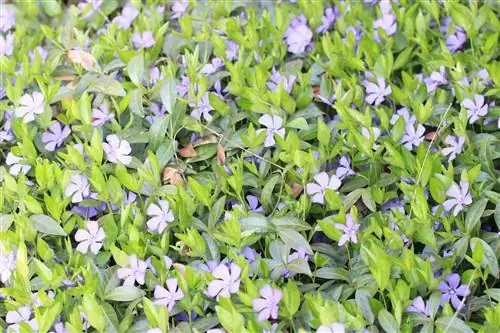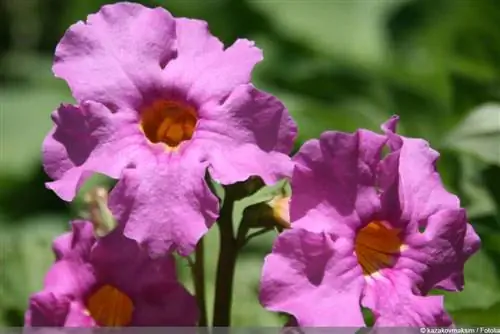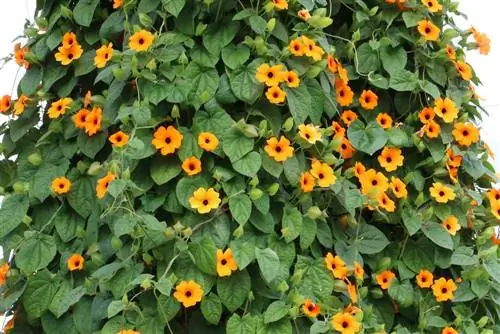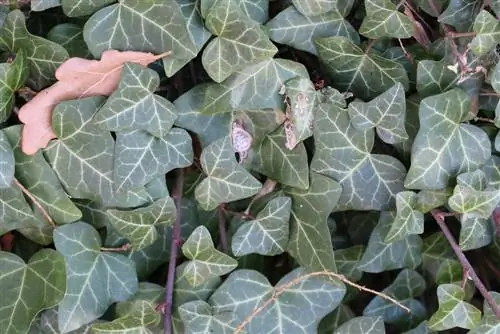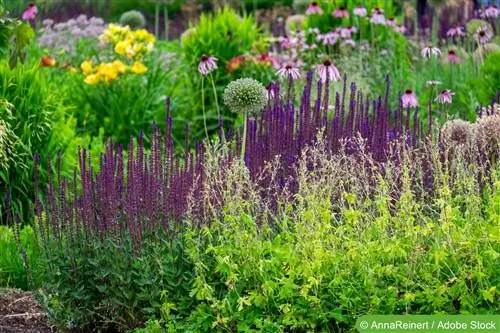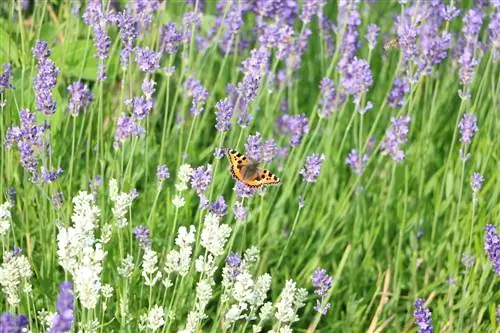- Author admin [email protected].
- Public 2023-12-17 03:39.
- Last modified 2025-06-01 06:48.
In every garden there are shady corners or slopes that can be beautified with ground cover plants. Alone on the bed, in colorful combinations or as underplanting - the possible areas of application are diverse and allow a great deal of design freedom. Of course, this only applies if the right species are selected.
Annual or perennial - tips for choosing
The distinction between annual or perennial flowering ground cover and plants in general is not always clear. And not always consistent. Not even if the classification is on the label or the seed bag. The reason for this lies in the winter hardiness of the plants. Many annual ground covers do not die because they really only have a limited lifespan. Instead, they are simply not frost hardy. If they are still described as “annual”, sowing seeds is usually much easier and less time-consuming than overwintering indoors. At least if the seeds are sown directly in the garden and not cultivated in a pot or bucket. If you have the space to safely overwinter and are planning to grow it in a pot anyway, you shouldn't be too quick to part with a supposedly annual plant. In the majority of cases, these survive the winter surprisingly well and without any problems, provided they are kept frost-free.
Annual flowering ground cover
The particularly easy-care yet decorative ground covers include:
Beach Silverweed
The beach silverwort originally comes from Madeira, but is finding more and more fans all over the world. This is due to its undemanding growth in sunny or partially shaded locations. And of course the white carpet of flowers that appears from June to December.
winds
The morning glory is a diverse plant that can spread quickly over large areas. Some gardeners therefore already consider it a weed. However, it impresses with decorative flowers that appear on it from June to around October. In addition to the annual versions, the morning glory is also available as a perennial garden plant.
Wild garlic
The wild garlic is not a typical ground cover in the garden, but it is a very attractive one. If it is kept sufficiently shady and moist, it will spread quickly and is also a delicious addition to the kitchen.
Nasturtium
The nasturtium is probably one of the best-known garden plants and is commercially available in many colors and cultivated forms. Actually perennial, it is mostly used as an annual ground cover, as overwintering, at least in the garden, is difficult.
Pennigkraut or Coinwort
The pennywort or coin herb grows to just five centimeters high and thrives best in partial shade. This means it can fill an important gap in the garden and is ideal as an underplant and solitary ground cover. It flowers yellow and can also be perennial with appropriate protection.
hornwort
The hornwort is characterized above all by its great tolerance to drought and impresses with its silvery, velvety leaves, from which the white flowers stand out beautifully.
Liver Balm
The liver balm blooms purple and interestingly feathered, from May to October. If you want particularly dense and magnificent flowers, you should choose a sunny location.
Perennial flowering ground cover
On the perennial flowering ground cover side, there are a variety of evergreen plants. The most undemanding include:
Small-leaved periwinkle
The small-leaved periwinkle is a shrub about 20 cm high that quickly grows over large areas and spreads out densely.
Flowering occurs from May to September if a suitable location is chosen. Small-leaved periwinkle likes shade or partial shade and is therefore ideal as an underplant.
Cotoneaster
The cotoneaster is an undemanding plant that thrives almost anywhere and makes an attractive ground cover. The flowers and fruits are small, but have a contrasting color.
St. John's Wort
The yellow-flowering St. John's wort has become an integral part of many gardens and likes to fill shady or semi-shady places. Because St. John's wort likes moist locations, it can also serve as a border for a garden pond.
stonecrop
The stonecrop is available in numerous cultivated forms and is particularly easy to care for. It can fill narrow niches or spread over large areas and feels particularly at home in the rock garden. If you really want little effort in the garden, stonecrop is a good choice.
Cushion bellflower
Cushion bellflowers form dense carpets that are simply an eye-catcher with their splendor of flowers. They appear very delicate and delicate, can be combined in many ways and can withstand a lot if watered adequately. Sunny or semi-shady locations - the cushion bellflowers thrive in both.
Rosemary-Daphne
The rosemary daphne is somewhat unusual and almost a rarity. It blooms in pink or hot pink and tolerates drought very well, which is why it looks beautiful in the rock garden - but can also be kept in the pot as an easy-care decoration.
Schuppenheide
At least one type of heather should not be missing from the list of easy-care, perennial and flowering ground covers. The perennial and attractive plants are small and low, but still spread quickly and powerfully. As long as they are not exposed to waterlogging, they prove to be robust garden plants.
Lower Mockberry
The lower false berry can grow quite light, but with proper care and a little pruning it can also spread wonderfully densely. The brightly colored flowers and berries are an eye-catcher that can be seen almost all year round.
Evening Primrose
The evening primrose can remain very low, but with the right variety it can even grow up to two meters high. Flowering yellow, it brings sun under the partially shaded ground cover. If it is watered sufficiently, it also tolerates sun well.
What you should know about annual and perennial groundcovers in brief
Selecting the right varieties from the multitude of flowering ground cover plants is not always easy, because everyone is spoiled for choice. But those who have passed this can enjoy easy-care and attractive plants that require little effort. There are shady corners in every garden. These often appear monotonous and colorless compared to the rest. This need not be. There are a variety of beautiful and easy-care ground cover plants such as lily of the valley, ivy, periwinkle, golden strawberry, ornamental nettle, Balkan cranesbill and fat man, which require little care and allow the bare corners to blossom.
For the period from December to March, the Christmas rose is ideal for shady corners. It has its heyday in these months. Then the wood anemones, which bloom with white and blue flowers from March, delight the eye, as do memorial flowers and leather flowers. For example, the larkspur blooms in April and May. Afterwards comes the time for the red stonecrop, the star umbels and the poppies. Autumn then belongs to the autumn anemones, the hardy outdoor fuchsias and the monkshood. These are plants that bloom until October.
Note:
For most plants, they are best planted in large groups. This allows them to spread and then cover a large area with colorful flowers. This looks beautiful.
- However, before you decide on a ground cover plant, it makes sense to know the nature of the soil.
- Ground cover plants, which usually cope well with life in the shade, but have different demands on the soil.
- Only in suitable soil can they thrive and fulfill their purpose of enlivening bare areas with colorful flowers.

